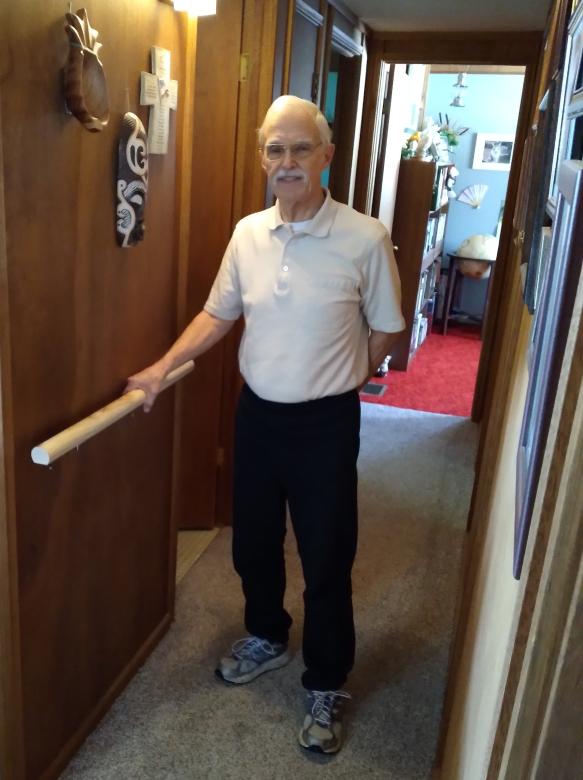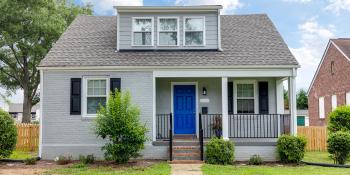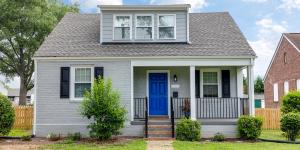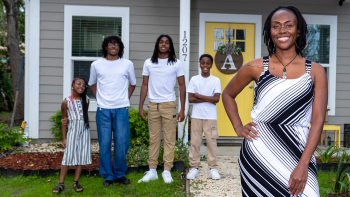Children, Cities and Housing: Rights and Priorities
Children living in inadequate housing in urban areas are one of the most vulnerable groups globally. Read our discussion paper, written in collaboration with UN-Habitat and UNICEF for the World Urban Forum, on challenges faced by children in urban areas and strategies to enable a sustainable future for them.
Drawing home
When we asked the children of Habitat for Humanity homeowners all around to draw how they see their homes, we were awed by their responses. Help us continue to work toward a world where everyone has a safe, decent and affordable place to live.
Aging in place with peace of mind
“Taking a shower and having proper handrails in the tub. The handrail in the hallway for helping us steady ourselves,” Bryant says. “They’re little things, but they’re game-changers when you get older.”
“We’ve been married for many, many, many, many years and have grown old together,” Bryant says with a chuckle, sitting beside his wife, Rosalyn, in the living room of their longtime home. The octogenarian couple were born and raised in the Fitchburg, Wisconsin, area and have spent most of their adult lives in nearby Baraboo, owning their beloved home for decades. One winter, the couple found the basement siding on their beloved home deteriorating and became concerned.
Bryant knew the siding needed replacement, a job the U.S. Army veteran would usually do himself, but that presented a challenge now with Rosalyn’s growing health care needs. “Though it’s a simple job, it is rather laborious for one person to do. Habitat has an excellent reputation, so I gave them a call to see if I could get assistance on the repair, and things just worked out very well,” Bryant says.
Partnering with Bryant and Rosalyn to make the needed improvements revealed other realities. “For me,” says Morgan Pfaff, executive director of Habitat for Humanity Wisconsin River Area, “it was realizing that health was creating greater barriers than simply issues with insulation.”
Partnering together, again
Habitat Wisconsin River Area’s region has a large number of older adults and aging veterans. In 2018, the Centers for Disease Control and Prevention found Wisconsin to have the nation’s highest average of deadly falls, more than half of those happening at home. The affiliate, already focusing on expanding their repair work, began to look for ways to grow their reach to include more local aging homeowners.
A few months after Bryant and Rosalyn’s insulation repairs, Habitat Wisconsin River Area was selected to participate in a pilot study funded by a grant from the RRF Foundation for Aging. Habitat Wisconsin River Area partnered with a local health care service to do home evaluations for local older adults who wish to age at home.
“The pilot allowed us to grow our repair work and specifically focus on aging in place. The home evaluation process taught us to better understand the needs of aging adults and what barriers might prevent them from remaining in their homes,” Morgan says.

When considering local homeowners to partner with on the pilot study, Morgan immediately thought of Bryant and Rosalyn, who enthusiastically agreed to participate. “It was really helpful for us that we were able to start off with people we already had a relationship with. The pre- and post-assessment goes deep. It asks a lot of questions and requires openness and candor from the homeowners.”
Little things that are game-changers
The RRF pilot study was done under the Housing Plus umbrella of work. As innovators of the Housing Plus model, Habitat uses a range of person-centered, holistic approaches that begin with the older adult’s needs, then builds a tailored plan that incorporates home repairs and modifications as well as community resources, like health care and veteran support. Home evaluations are done with a housing expert from Habitat and a local medical services worker.
The success of the pilot allowed Habitat Wisconsin River Area to create a dedicated staff position to sustain this work.
“Coming at it with a Housing Plus approach, we’re looking at the bigger picture,” says Roy Mares, repairs manager. “We’re looking at more than building a ramp and finding where to put grab bars. It’s improving the home for better accessibility, but it’s going beyond that. It’s connecting people to resources that they can use in their lives. It’s making their homes fit their lives instead of making their lives fit their house.”
That’s certainly been the case for Bryant and Rosalyn. The couple’s home is equipped with well-placed modifications that help Rosalyn navigate the space, giving Bryant peace of mind as her caregiver. “It’s improved the day-to-day. Taking a shower and having proper handrails in the tub. The handrail in the hallway for helping us steady ourselves,” Bryant says. “They’re little things, but they’re game-changers when you get older.”

Aging in place with peace of mind

Habitat for Humanity International launches initiative to address the Black homeownership gap in the U.S.
Advancing Black homeownership in Richmond
Mary Kay Huss, Richmond Metropolitan Habitat chief executive officer, talks about historic housing discrimination and what Habitat is doing to help advance Black homeownership locally.
For Black Americans, the barriers to homeownership created by historic discrimination in the U.S. housing market still persist today. From redlining neighborhoods, a practice where Black families were denied home loans based on color-coded maps developed by the federal Home Owners’ Loan Corporation in the 1930s, to racially restrictive covenants stipulating that homes were only sold or resold to white families, the list of housing discriminations meant to deny Black individuals the opportunity to build a better life has had far-reaching consequences across wealth, health, education and employment.
Mary Kay Huss, chief executive officer of Richmond Metropolitan Habitat for Humanity, has worked in the affordable housing sector for nearly 30 years. “We can’t change the past,” she says. “But what we can do is do the next right thing every time, and that is providing homeownership opportunities.”

Mary Kay Huss, chief executive officer of Richmond Metropolitan Habitat for Humanity
Mary Kay sheds light on the history of housing inequity in Richmond, Virginia, and shares how Richmond Habitat brings people together to create equitable housing opportunities for all.
What are some of the barriers that have prevented Black residents in Richmond from becoming homeowners?
The decision to build two highways through Richmond bisected once-thriving communities of color and isolated them. Public housing communities in Richmond were built and cordoned off by these highways, concentrating poverty in these areas and really making it difficult for those residents to access homeownership and other services. Redlining took place, and decades of this systemic racism created the racial disparity that we see in homeownership today.
How do these barriers to homeownership continue to affect Black residents who want to become homeowners in Richmond today?
Real estate taxes and the values of homes are going up. However, some of the lower-value homes in non-white neighborhoods are a prime example of racial bias in real estate valuations. Some of those older, non-white neighborhoods have lower values. So even if Black residents are able to own homes in these areas, they’re not able to add to their equity and subsequently add to their generational wealth as quickly or as much as they could if they were living in another neighborhood. Our city council has budgeted for our fair housing organization to examine the fairness of those property values and see if they’ve been kept artificially depressed, even as real estate values have soared in other parts of the city.
What is the reality of the homeownership gap in your area?
Black homeownership is at its lowest level. Only 48% of Black households in Virginia own their homes, as compared to 73% of white households.
What has Richmond Habitat done to prioritize Black homeownership?
This year, Richmond Habitat worked on a constitutional amendment for tax relief for long-term residents. It’s aimed at allowing an expansion of the tax relief program currently in place in the city to apply to long-term residents so that we can keep them in gentrifying neighborhoods. In the state of Virginia, that bill has to go to the General Assembly and has to be enacted to a constitutional amendment. It has to be presented two years in a row. Along with our partner, the Virginia Housing Alliance, we talked to our legislators who were willing to patron that bill. It was presented this first year, and we will do it again next year.
Also, working with our local housing authority, we were able to obtain over 30 vacant properties that were located in a desirable part of the city close to the river. We call that neighborhood the Maymont-Randolph neighborhood, and over the past three years we’ve been systematically working on those vacant properties, some of which were homes that had been moved in order to make room for highways. They were once boarded up and really a blight in that community. And we, along with another nonprofit who also got 37 properties, really were able to change the demographics of an entire block and bring in new homeowners, including Habitat homeowners that were making anywhere between 30 and 60% of the area median income.
Why is advancing Black homeownership a priority for Richmond Habitat?
It’s what we’ve always done, but George Floyd and the racial reckoning that happened around that time really impacted the city of Richmond. We’re known as the capital of the Confederacy, and there was a lot of public outcry about Confederate monuments over the past two years. That all brought the inequities to the forefront.
Providing equitable homeownership opportunities to those who didn’t have a level playing field is, again, something we’ve always done, but we hadn’t really talked about it that way. We changed our narrative to talk about advancing Black homeownership in a way that was very relevant to Richmond. I started emphasizing equitable access to homeownership for Black homeowners and people of color, and in the audiences I would see heads start nodding.
The more we more we learn about it, the more we understand that we have to keep doing this, and we have to do it in a bigger way. We have to do more of it because there have been inequities for decades. I don’t know that we can ever turn it around or solve it —but we can keep doing this work because it’s important and it’s necessary.

Advancing Black homeownership in Richmond

Closing the racial homeownership gap in the U.S.
As part of our +You thought leadership series, a group of experts gathered for a livestream event to explore the deep-seated inequities in America’s housing market – and the steps necessary to create more inclusive housing practices.
Advancing Black Homeownership
Habitat for Humanity’s vision is a world where everyone has a decent place to live, but a structure of intentional and systemic racial discrimination in the U.S. has created barriers to homeownership for many Black families.
Habitat for Humanity International and Lowe’s continue partnership, announce new strategic focus to support home repair and rehab projects across the U.S.
Capacity statements
See our global capacity overview or read Habitat’s country level capacity statements, which include specific areas of programming and expertise.


